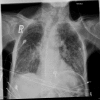Middle East respiratory syndrome coronavirus: a case-control study of hospitalized patients
- PMID: 24723278
- PMCID: PMC7108071
- DOI: 10.1093/cid/ciu226
Middle East respiratory syndrome coronavirus: a case-control study of hospitalized patients
Abstract
Background: There is a paucity of data regarding the differentiating characteristics of patients with laboratory-confirmed and those negative for Middle East respiratory syndrome coronavirus (MERS-CoV).
Methods: This is a hospital-based case-control study comparing MERS-CoV-positive patients (cases) with MERS-CoV-negative controls.
Results: A total of 17 case patients and 82 controls with a mean age of 60.7 years and 57 years, respectively (P = .553), were included. No statistical differences were observed in relation to sex, the presence of a fever or cough, and the presence of a single or multilobar infiltrate on chest radiography. The case patients were more likely to be overweight than the control group (mean body mass index, 32 vs 27.8; P = .035), to have diabetes mellitus (87% vs 47%; odds ratio [OR], 7.24; P = .015), and to have end-stage renal disease (33% vs 7%; OR, 7; P = .012). At the time of admission, tachypnea (27% vs 60%; OR, 0.24; P = .031) and respiratory distress (15% vs 51%; OR, 0.15; P = .012) were less frequent among case patients. MERS-CoV patients were more likely to have a normal white blood cell count than the control group (82% vs 52%; OR, 4.33; P = .029). Admission chest radiography with interstitial infiltrates was more frequent in case patients than in controls (67% vs 20%; OR, 8.13; P = .001). Case patients were more likely to be admitted to the intensive care unit (53% vs 20%; OR, 4.65; P = .025) and to have a high mortality rate (76% vs 15%; OR, 18.96; P < .001).
Conclusions: Few clinical predictors could enhance the ability to predict which patients with pneumonia would have MERS-CoV. However, further prospective analysis and matched case-control studies may shed light on other predictors of infection.
Keywords: MERS; case-control; coronavirus; radiographic characteristics.
© The Author 2014. Published by Oxford University Press on behalf of the Infectious Diseases Society of America. All rights reserved. For Permissions, please e-mail: journals.permissions@oup.com.
Figures
References
-
- Zaki AM, van Boheemen S, Bestebroer TM, Osterhaus AD, Fouchier RA. Isolation of a novel coronavirus from a man with pneumonia in Saudi Arabia. N Engl J Med. 2012;367:1814–20. - PubMed
-
- Hijawi B, Abdallat M, Sayaydeh A, et al. Novel coronavirus infections in Jordan, April 2012: epidemiological findings from a retrospective investigation. East Mediterr Health J. 2013;19(suppl 1):S12–8. - PubMed
-
- Joint Kingdom of Saudi Arabia/WHO mission. Riyadh, Saudi Arabia: 2013. Middle East respiratory syndrome coronavirus. Available at: http://www.who.int/csr/disease/coronavirus_infections/MERSCov_WHO_KSA_Mi.... Accessed 12 December 2013.
-
- Al-Tawfiq JA, Assiri A, Memish ZA. Middle East respiratory syndrome novel corona MERS-CoV infection. Epidemiology and outcome update. Saudi Med J. 2013;34:991–4. - PubMed
-
- Saudi Ministry of Health—novel coronavirus - media statements. Available at: http://www.moh.gov.sa/en/CoronaNew/PressReleases/Pages/default.aspx . Accessed 20 November 2013.
MeSH terms
LinkOut - more resources
Full Text Sources
Other Literature Sources
Medical



